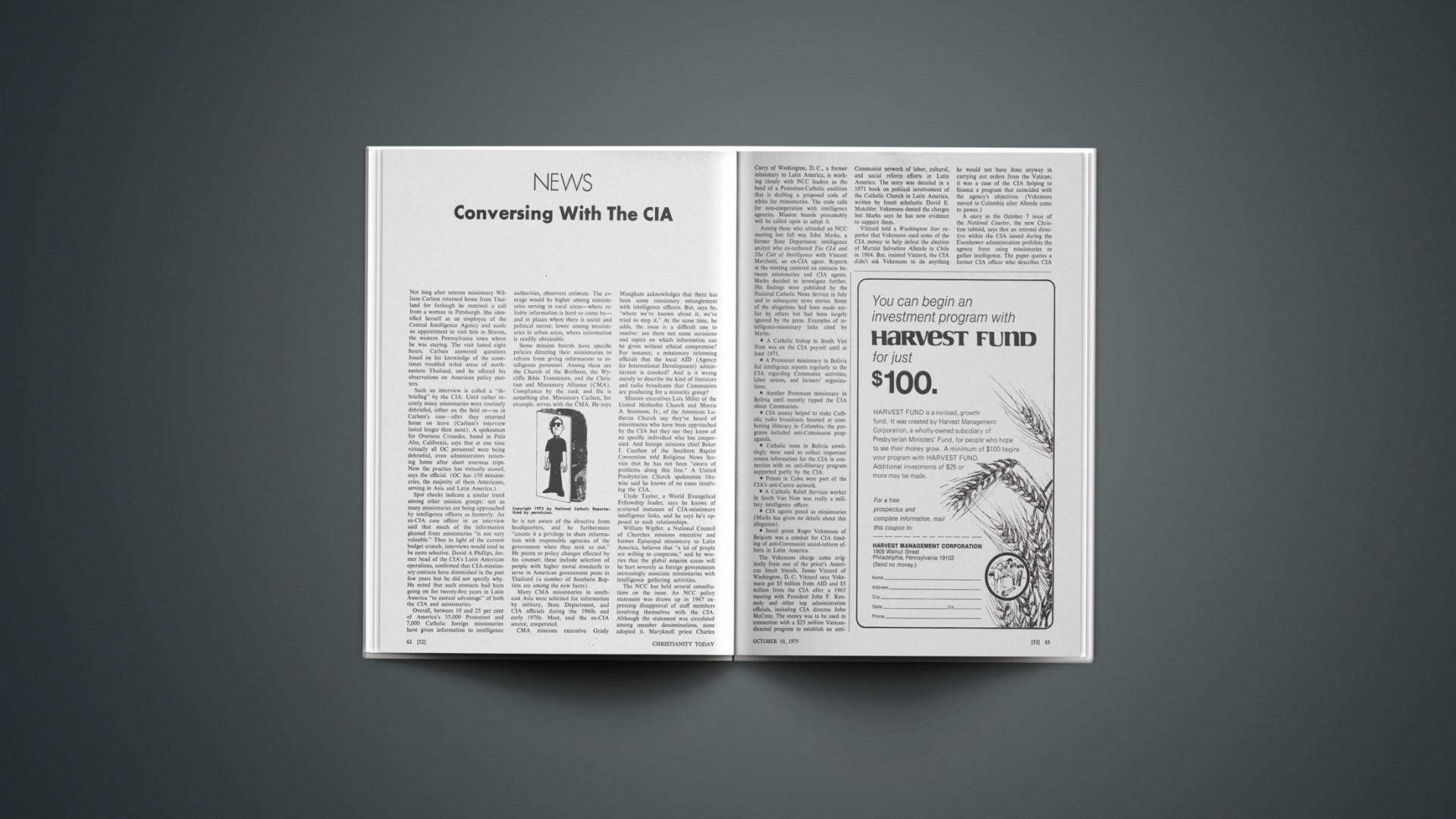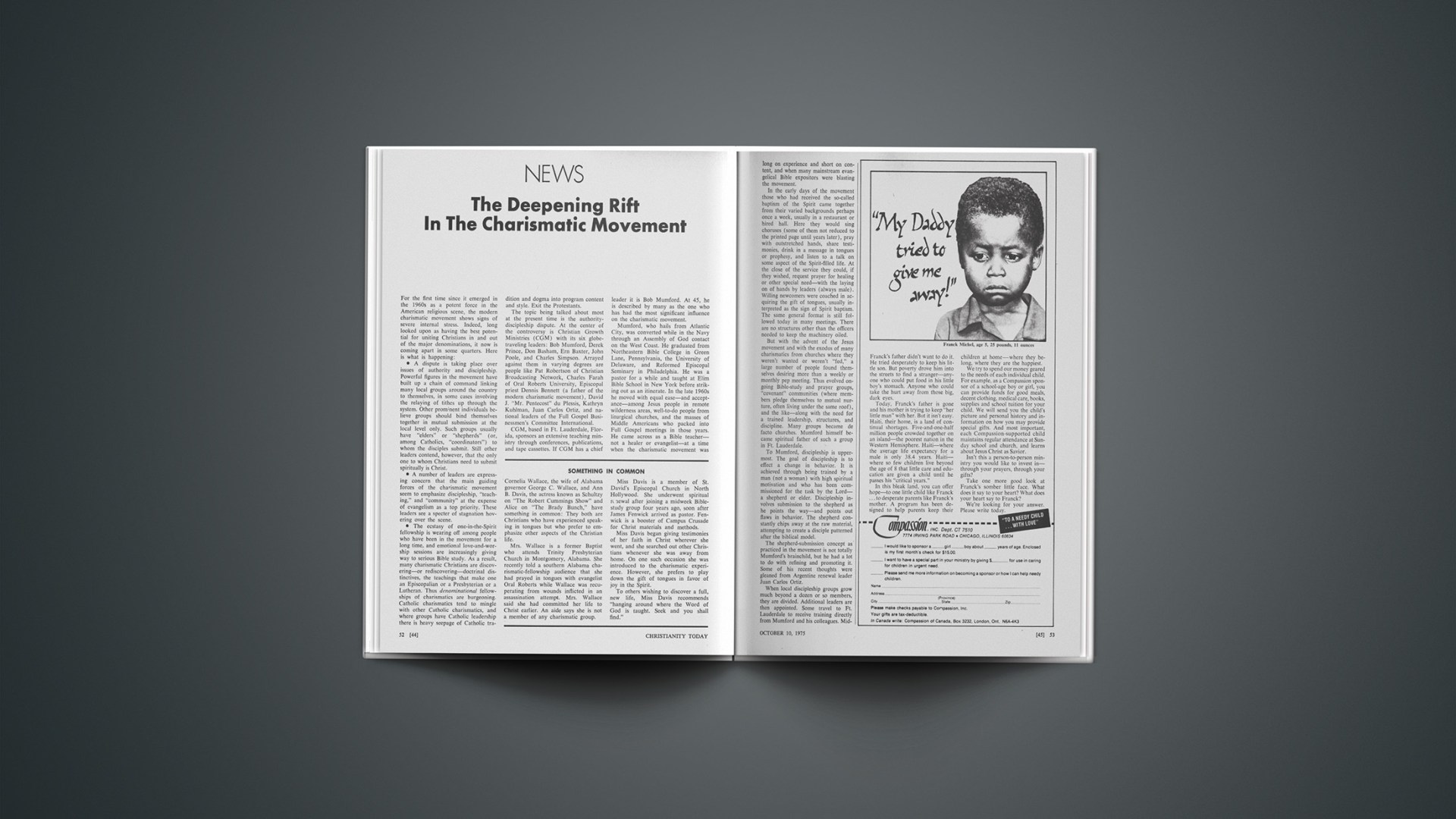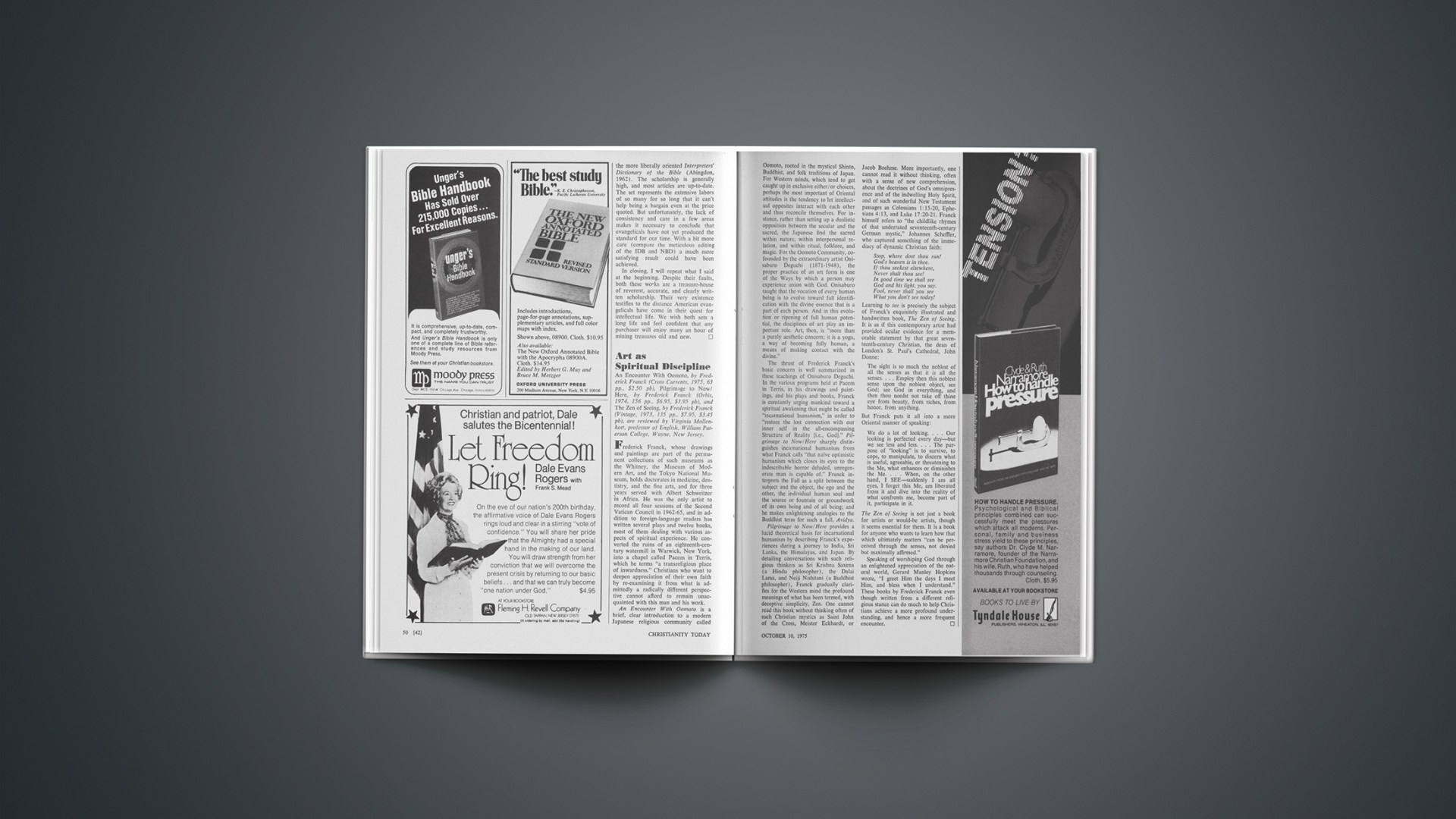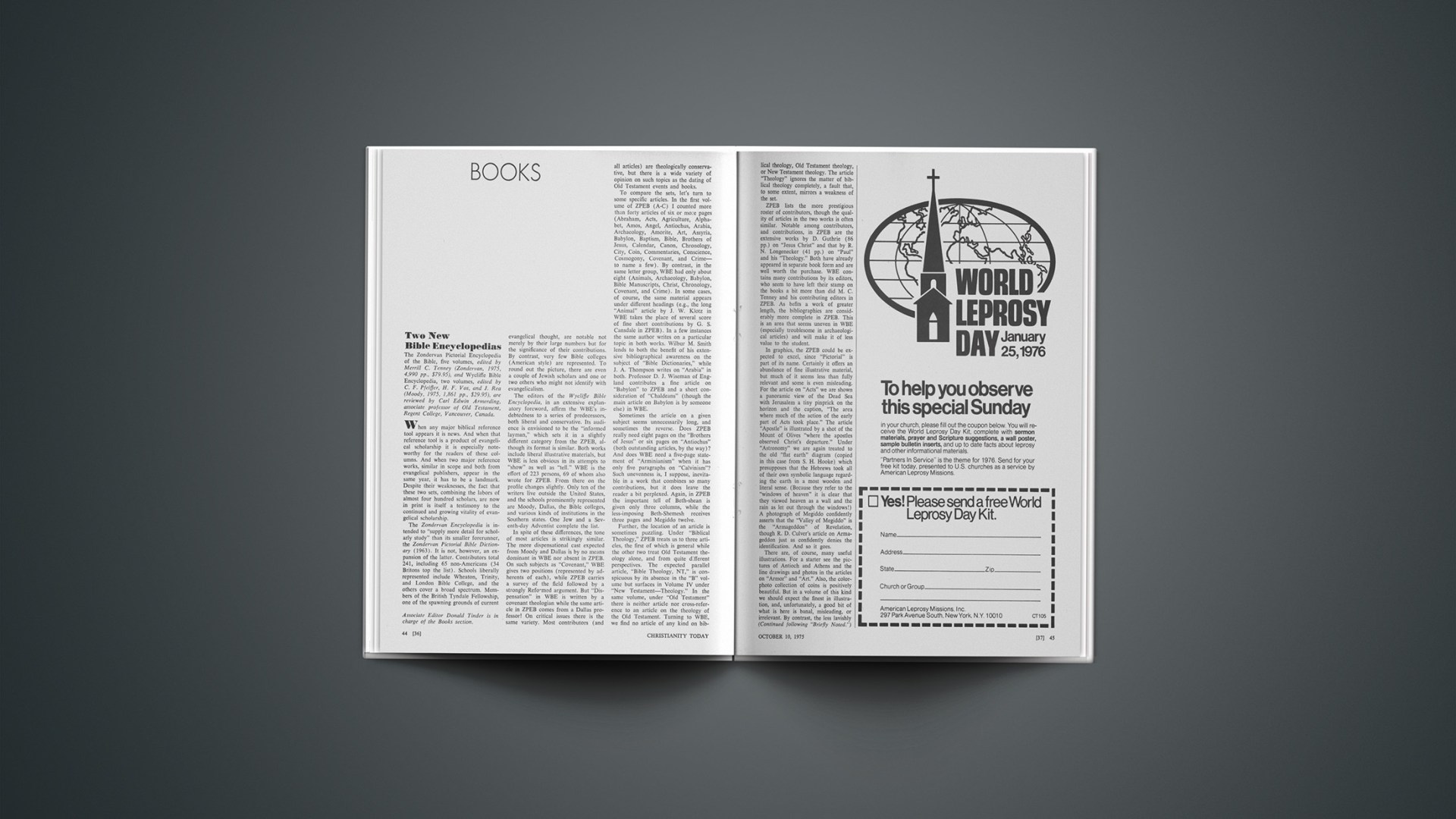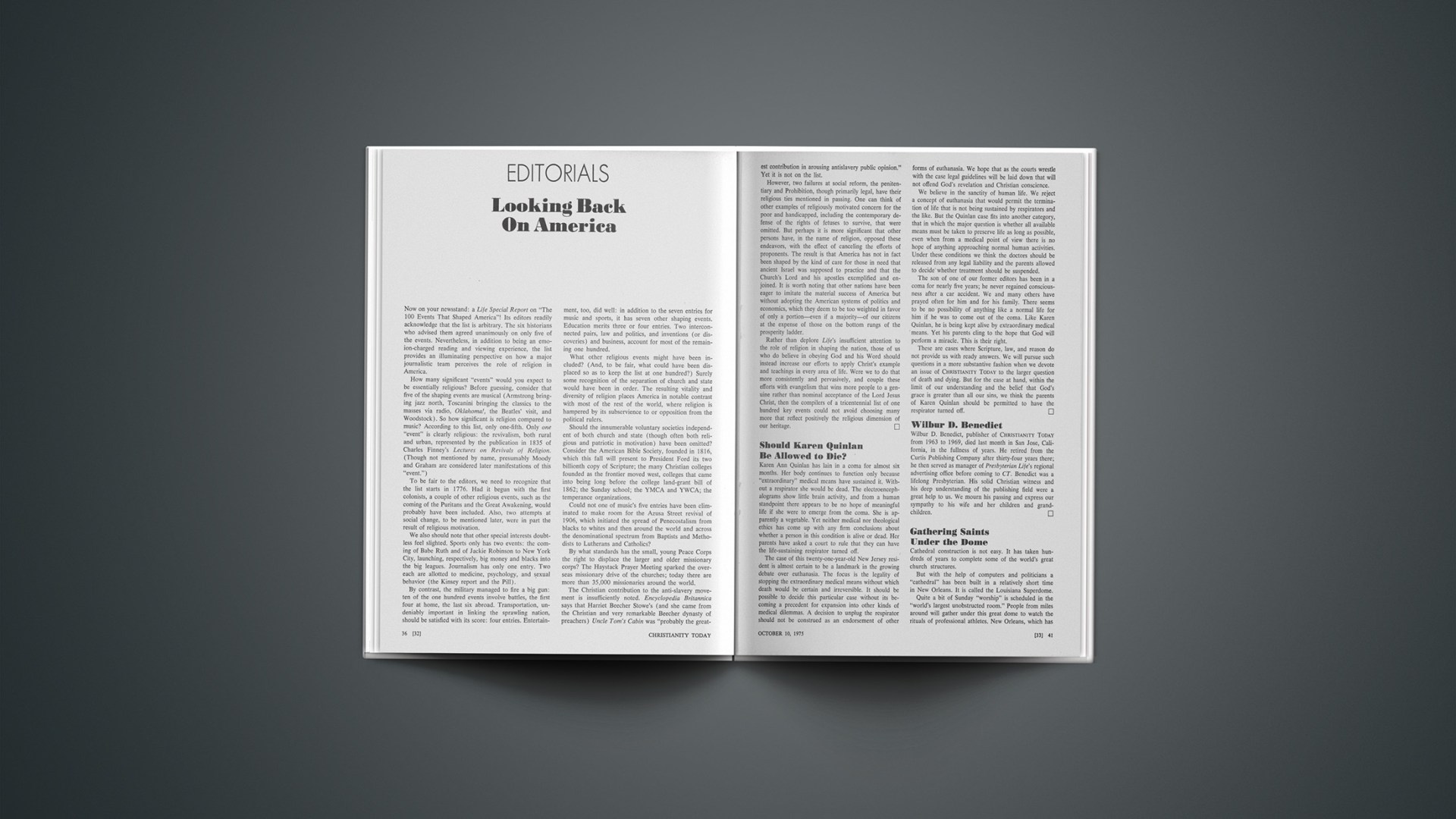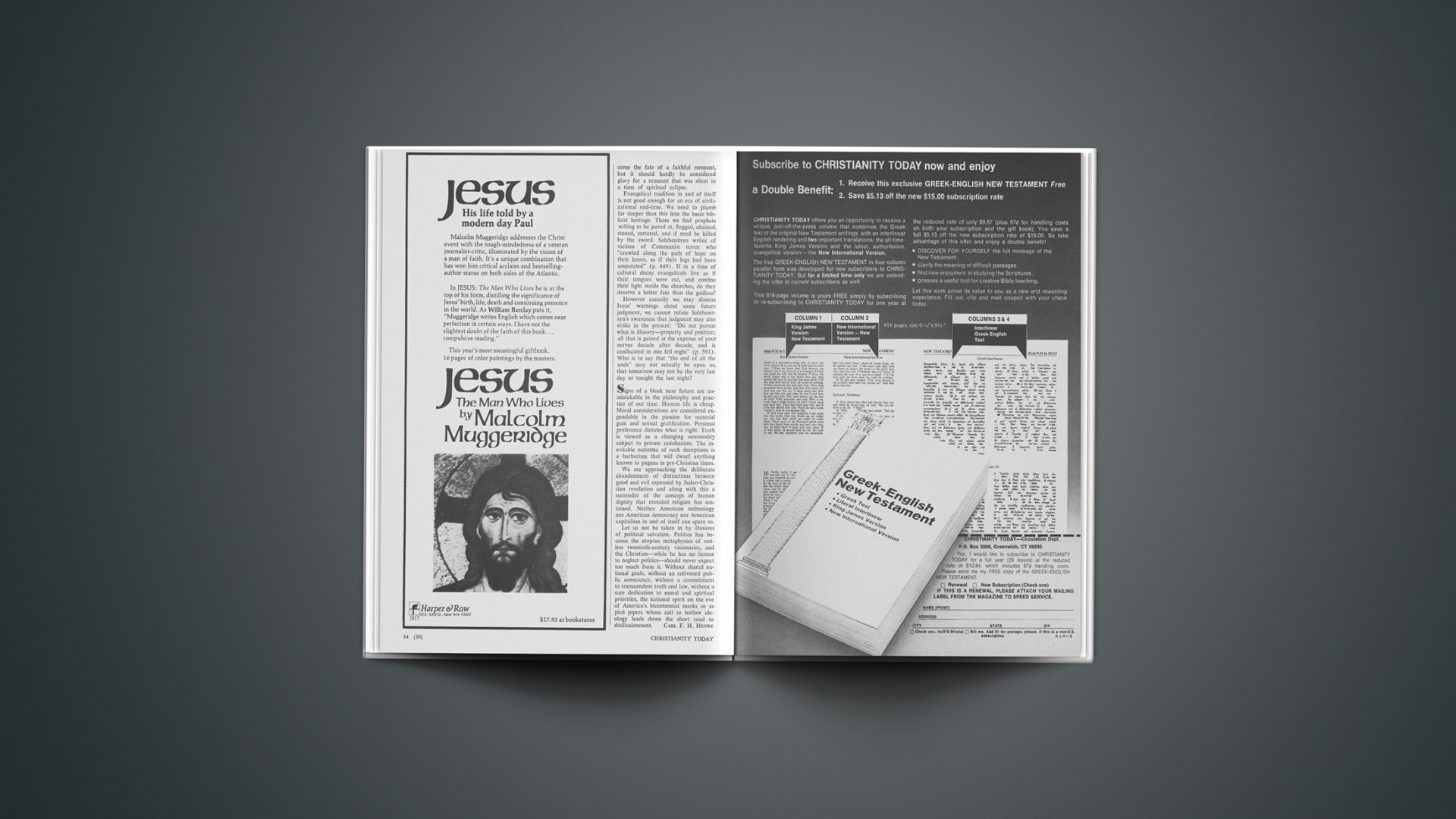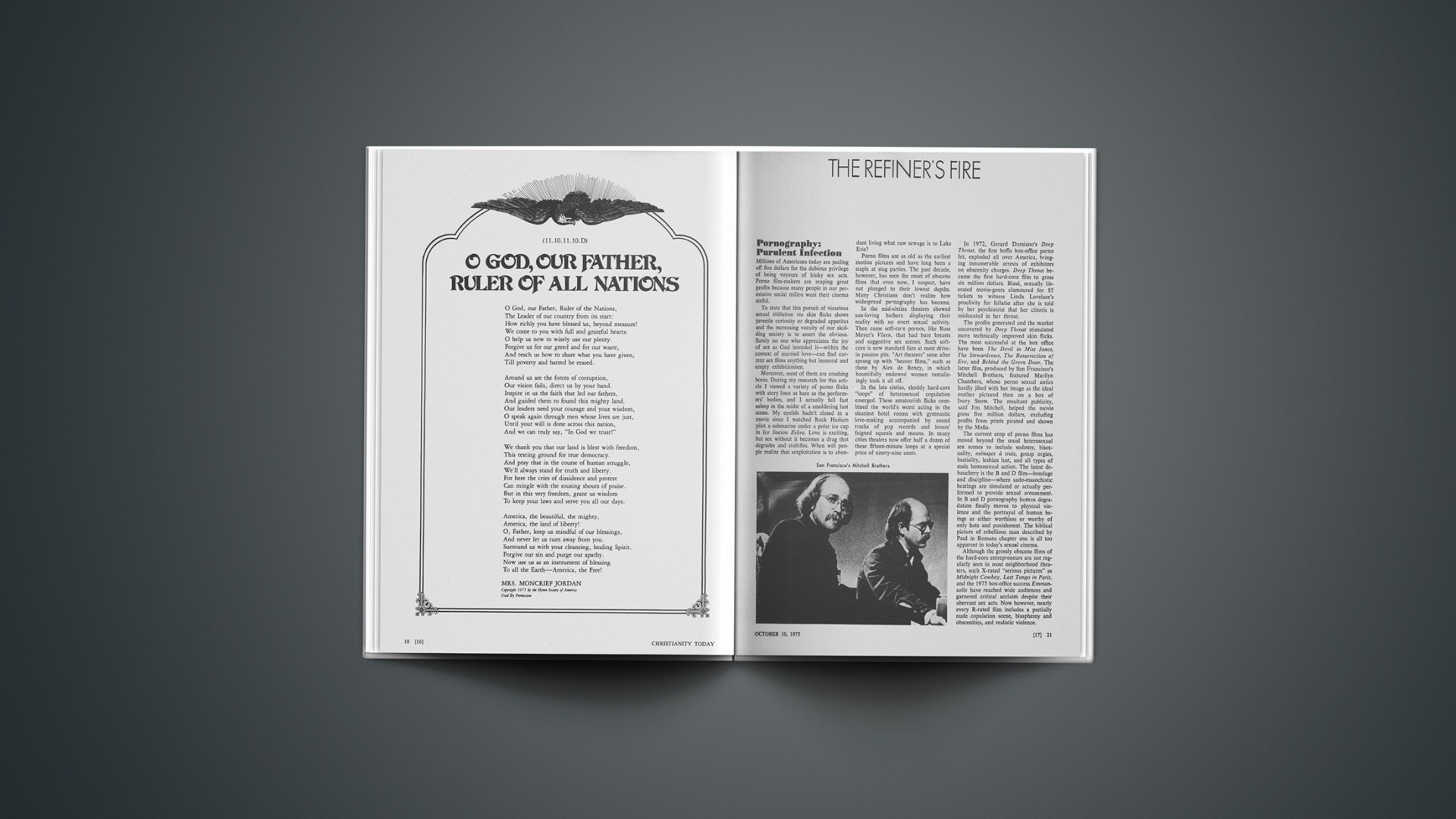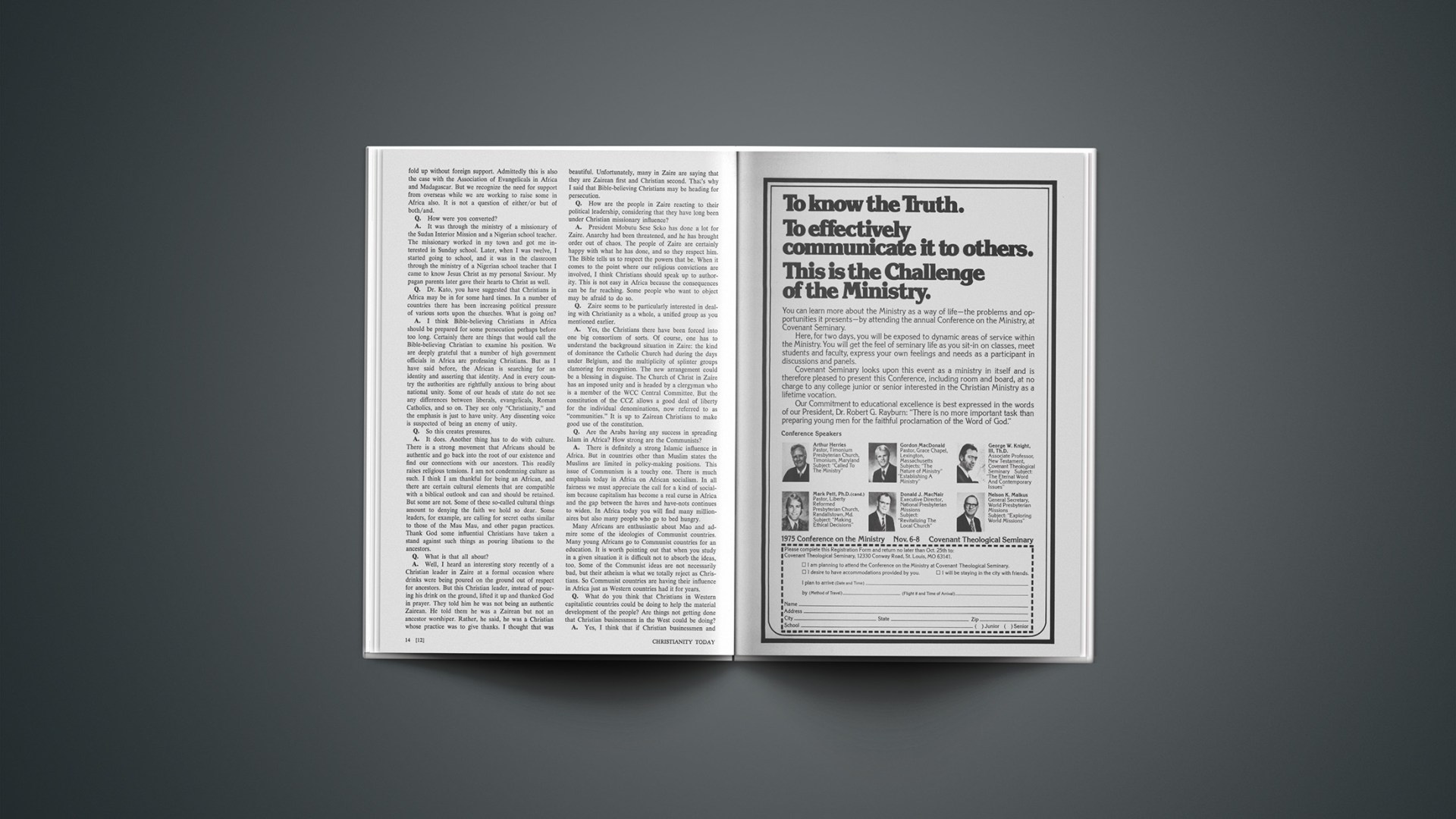For the first time since it emerged in the 1960s as a potent force in the American religious scene, the modern charismatic movement shows signs of severe internal stress. Indeed, long looked upon as having the best potential for uniting Christians in and out of the major denominations, it now is coming apart in some quarters. Here is what is happening:
• A dispute is taking place over issues of authority and discipleship. Powerful figures in the movement have built up a chain of command linking many local groups around the country to themselves, in some cases involving the relaying of tithes up through the system. Other prominent individuals believe groups should bind themselves together in mutual submission at the local level only. Such groups usually have “elders” or “shepherds” (or, among Catholics, “coordinators”) to whom the disciples submit. Still other leaders contend, however, that the only one to whom Christians need to submit spiritually is Christ.
• A number of leaders are expressing concern that the main guiding forces of the charismatic movement seem to emphasize discipleship, “teaching,” and “community” at the expense of evangelism as a top priority. These leaders see a specter of stagnation hovering over the scene.
• The ecstasy of one-in-the-Spirit fellowship is wearing off among people who have been in the movement for a long time, and emotional love-and-worship sessions are increasingly giving way to serious Bible study. As a result, many charismatic Christians are discovering—or rediscovering—doctrinal distinctives, the teachings that make one an Episcopalian or a Presbyterian or a Lutheran. Thus denominational fellowships of charismatics are burgeoning. Catholic charismatics tend to mingle with other Catholic charismatics, and where groups have Catholic leadership there is heavy seepage of Catholic tradition and dogma into program content and style. Exit the Protestants.
The topic being talked about most at the present time is the authority-discipleship dispute. At the center of the controversy is Christian Growth Ministries (CGM) with its six globe-traveling leaders: Bob Mumford, Derek Prince, Don Basham, Ern Baxter, John Poole, and Charles Simpson. Arrayed against them in varying degrees are people like Pat Robertson of Christian Broadcasting Network, Charles Farah of Oral Roberts University, Episcopal priest Dennis Bennett (a father of the modern charismatic movement), David J. “Mr. Pentecost” du Plessis, Kathryn Kuhlman, Juan Carlos Ortiz, and national leaders of the Full Gospel Businessmen’s Committee International.
CGM, based in Ft. Lauderdale, Florida, sponsors an extensive teaching ministry through conferences, publications, and tape cassettes. If CGM has a chief leader it is Bob Mumford. At 45, he is described by many as the one who has had the most significant influence on the charismatic movement.
Mumford, who hails from Atlantic City, was converted while in the Navy through an Assembly of God contact on the West Coast. He graduated from Northeastern Bible College in Green Lane, Pennsylvania, the University of Delaware, and Reformed Episcopal Seminary in Philadelphia. He was a pastor for a while and taught at Elim Bible School in New York before striking out as an itinerate. In the late 1960s he moved with equal ease—and acceptance—among Jesus people in remote wilderness areas, well-to-do people from liturgical churches, and the masses of Middle Americans who packed into Full Gospel meetings in those years. He came across as a Bible teacher—not a healer or evangelist—at a time when the charismatic movement was long on experience and short on content, and when many mainstream evangelical Bible expositors were blasting the movement.
In the early days of the movement those who had received the so-called baptism of the Spirit came together from their varied backgrounds perhaps once a week, usually in a restaurant or hired hall. Here they would sing choruses (some of them not reduced to the printed page until years later), pray with outstretched hands, share testimonies, drink in a message in tongues or prophesy, and listen to a talk on some aspect of the Spirit-filled life. At the close of the service they could, if they wished, request prayer for healing or other special need—with the laying on of hands by leaders (always male). Willing newcomers were coached in acquiring the gift of tongues, usually interpreted as the sign of Spirit baptism. The same general format is still followed today in many meetings. There are no structures other than the officers needed to keep the machinery oiled.
But with the advent of the Jesus movement and with the exodus of many charismatics from churches where they weren’t wanted or weren’t “fed,” a large number of people found themselves desiring more than a weekly or monthly pep meeting. Thus evolved ongoing Bible-study and prayer groups, “covenant” communities (where members pledge themselves to mutual nurture, often living under the same roof), and the like—along with the need for a trained leadership, structures, and discipline. Many groups became de facto churches. Mumford himself became spiritual father of such a group in Ft. Lauderdale.
To Mumford, discipleship is uppermost. The goal of discipleship is to effect a change in behavior. It is achieved through being trained by a man (not a woman) with high spiritual motivation and who has been commissioned for the task by the Lord—a shepherd or elder. Discipleship involves submission to the shepherd as he points the way—and points out flaws in behavior. The shepherd constantly chips away at the raw material, attempting to create a disciple patterned after the biblical model.
The shepherd-submission concept as practiced in the movement is not totally Mumford’s brainchild, but he had a lot to do with refining and promoting it. Some of his recent thoughts were gleaned from Argentine renewal leader Juan Carlos Ortiz.
When local discipleship groups grow much beyond a dozen or so members, they are divided. Additional leaders are then appointed. Some travel to Ft. Lauderdale to receive training directly from Mumford and his colleagues. Middle-level leaders often travel to other localities, establishing groups. Lines of responsibility and authority nevertheless lead back to Ft. Lauderdale. Tithes are split between local and regional staffers, sometimes with national leaders. In the chain of command, the six CGM top-level leaders see themselves as apostles.
Those being discipled must consult with their shepherds about many personal decisions. In some cases, shepherds forbid marriages, reject school and vocational plans, demand confession of secret sins.
Mumford says he has not seen the established churches producing discipies. Therefore, he confides to some, God must be doing a new thing—turning away from the churches and toward the shepherd-type groups. An amillennialist, he believes God is going to set up his government on earth through the (renewed) Church.
In 1973, Pastor Dick Coleman of the Westside Baptist Church in Leesburg, Florida, organized a “Shepherds’ Conference” where small-group leaders could come and receive inspiration and instruction for their tasks. (Not all groups are related to CGM.) Last year’s conference was held at Montreat, North Carolina, and the program—as this year’s—reflected substantial CGM input.
Criticism of shepherd-group practices surfaced this year, mainly among older charismatics. In a memo to his staff in May, broadcaster Pat Robertson declared, “Our board of directors is unalterably opposed to a charismatic dictatorship where self-appointed elders begin to take unscriptural control of the lives of others, thereby usurping the role of the Holy Spirit and Jesus Christ himself.” In a later memo he banned CGM speakers from his fifty-four radio and television outlets across the country, and he ordered all tapes of their messages in stock destroyed. He also broadcast an attack against CGM. A sharp exchange of letters followed between Robertson and Mumford.
A frequent criticism is the aloofness of CGM groups from other charismatic groups in many communities.
In August, a secret meeting of charismatic leadership was held in Minneapolis to discuss the situation. The thirty participants represented a veritable who’s who in the movement. Robertson, Episcopalian Bennett, and the Full Gospel Businessmen’s representatives pressed hard against Mumford and the other CGM leaders there. Nothing was really agreed upon except to meet again sometime. Robertson was mildly rebuked for his public handling of the matter, but majority sentiment ran against the CGM men. Ortiz said he believes in “horizontal” relationships among local members of groups, not trans-local “vertical” ones. (In plurality, there is equality, Ortiz teaches; in plurality there are differences, replies Mumford.)
At last month’s Shepherds’ Conference in Kansas City, Missouri, the CGM leaders resisted attempts to turn the platform into a forum for divergent views. Charles Farah was unable to read his statement calling on the Mumford coalition to lay aside the trans-local chain of command and the use of the word “church” employed by some CGM groups. Issues were discussed in seminar and question-answer sessions, however, by the 4,500 men.
CGM’s John Poole, a Philadelphia pastor, acknowledges that some criticism is justified: “our quickness to talk before testing, our difficulty in exerting corrective authority where we have influence but don’t want it.” He indicated that the CGM leaders, who have met several times to discuss strategy, will try to cut some of the umbilical ties to Ft. Lauderdale and concentrate on building a showcase model of biblical discipleship at the local level.
SOMETHING IN COMMON
Cornelia Wallace, the wife of Alabama governor George C. Wallace, and Ann B. Davis, the actress known as Schultzy on “The Robert Cummings Show” and Alice on “The Brady Bunch,” have something in common: They both are Christians who have experienced speaking in tongues but who prefer to emphasize other aspects of the Christian life.
Mrs. Wallace is a former Baptist who attends Trinity Presbyterian Church in Montgomery, Alabama. She recently told a southern Alabama charismatic-fellowship audience that she had prayed in tongues with evangelist Oral Roberts while Wallace was recuperating from wounds inflicted in an assassination attempt. Mrs. Wallace said she had committed her life to Christ earlier. An aide says she is not a member of any charismatic group.
Miss Davis is a member of St. David’s Episcopal Church in North Hollywood. She underwent spiritual renewal after joining a midweek Bible-study group four years ago, soon after James Fenwick arrived as pastor. Fenwick is a booster of Campus Crusade for Christ materials and methods.
Miss Davis began giving testimonies of her faith in Christ wherever she went, and she searched out other Christians whenever she was away from home. On one such Occasion she was introduced to the charismatic experience. However, she prefers to play down the gift of tongues in favor of joy in the Spirit.
To others wishing to discover a full, new life, Miss Davis recommends “hanging around where the Word of God is taught. Seek and you shall find.”
Rebuked
Taking its harshest action since criticizing the late Bishop James A. Pike in 1966 for making “irresponsible” utterances, the House of Bishops of the Episcopal Church last month censured three of its members and voted to “decry” the action of another.
In a three-part resolution the bishops voted 119 to 18 with seven abstentions to repudiate the actions of fellow bishops who had ordained women to the priesthood in violation of church policy. They voted 118 to 8 with eight abstentions to censure Robert L. DeWitt, resigned bishop of Pennsylvania; Daniel N. Corrigan, retired bishop of Colorado; and Edward E. Welles, retired bishop of West Missouri. The three last year ordained eleven women in Philadelphia in a service the House of Bishops later ruled was invalid. Disciplinary charges were not pursued after an inquiry panel decided it had no jurisdiction. The panel ruled that the case involved doctrinal issues.
The bishops decided to decry the action of George W. Barrett, 67, resigned bishop of Rochester (New York) who lives in California, rather than to censure him because to do so might prejudice possible ecclesiastical court action that may be brought against him. The action passed 116 to 16 with twelve abstentions. Barrett earlier last month ordained four women at the Church of St. Stephen and the Incarnation in Washington, D. C.—ignoring the objections of Bishop William F. Creighton of Washington. Specific charges were reportedly being drawn up against Barrett by several other bishops. Meanwhile, Bishop Robert C. Rusack of the Diocese of Los Angeles revoked Barrett’s license to officiate at church rites in the diocese.
Censure has little effect other than public rebuke, but spokesmen said it was the only action short of a full-fledged doctrinal trial that the bishops could take. Many of the controversially ordained women at the invitation of some rectors and churches are performing priestly functions. Disputes over these actions, however, must be thrashed out at the local diocesan level.
Captive In Chad
Paul Horala of Strasbourg, France, a missionary of the Sudan United Mission, was still being held hostage last month after his capture in June by anti-government militants in northeastern Chad. They ransacked the mission station and stole a vehicle. Mrs. Pauline Horala, who returned to France after the incident in the African nation, said she has received two letters from her husband, the latest dated July 31 saying the rebels had not yet received orders from their leaders as to what to do with their captive.
The Black Baptists: Handling History
Historic roots of black Baptists were a top topic of speechmakers as three major conventions met simultaneously in September. Featured at the St. Louis meeting of the largest group, the National Baptist Convention, U.S.A., Incorporated, was President Gerald Ford.
Speaking on a Bicentennial theme, the President lauded the contributions that individual blacks and their churches have made to America.
Before the nation’s chief executive was welcomed to the NBCUSA’s platform, Illinois state senate leader Cecil A. Partee and also a Los Angeles pastor delivered speeches urging black participation in the Bicentennial. The recommedations were contrary to advice that has been coming from some black activists who oppose the celebration.
In Atlantic City, New Jersey, the Progressive National Baptist Convention took the position that black Americans should join in the observance of the country’s two-hundredth birthday, but only if the emphasis is on repentance. President Nelson H. Smith of Birmingham asserted: “I believe that the role that blacks should take in the Bicentennial is one of reminding our nation of her sacred promises in the Declaration of Independence.”
The 5,000 PNBC delegates at Atlantic City voted to stage a pageant in Washington, D. C., next September to spell out the contributions of blacks to the building of America. In another move related to their history, the “Progressives” launched tentative plans for a special centennial celebration in 1980 to commemorate the founding of the National Baptist organization from which the three conventions have developed.
Two of the three held a joint session in Atlantic City. A caravan of some twenty buses and 100 automobiles brought delegates from the Philadelphia site of the meeting of the (“unincorporated”) National Baptist Convention of America. Among the speakers at the joint session was Pennsylvania governor Milton J. Shapp, an aspirant for the Democratic Presidential nomination. He blasted Ford administration policies.
NBCUSA, the most conservative of the three groups, elected its president, Joseph H. Jackson of Chicago, to an unprecedented twenty-second term. An estimated 12,500 delegates rose to give him a unanimous vote.
In another action thought to be without precedent, the NBCUSA elected Cecilia N. Adkins executive director of its Nashville-based Sunday School Publishing Board. Mrs. Adkins, a board executive for fifteen years, is believed to be the first woman in the United States to head a major denominational publishing house.
While no current statistics are available, the NBCUSA claims to be the largest of the black church bodies, with an estimated 6.5 million members. The NBCA, which met in Philadelphia, claims 2.5 million, and the Progressive convention has an estimated 500,000.
New Readers Get The Word
Thanks to a scientifically designed program of the American Bible Society, millions more have read Scripture for themselves the past two years. Spokesmen say the society’s “Good News for New Readers” literature (see October 12, 1973, page 60) has been received at the grass roots with much enthusiasm. In some countries, Bible distribution groups are having a hard time keeping up with the demand.
The program is aimed at the growing number of newly literate people around the world, most of whom have nothing to read, let alone the Bible. Studies show that about half the people who learn to read will lose the skill unless they get access to reading material. It is said that there will be an estimated one billion new readers by the year 2000.
The Scripture selections aimed at new readers were the fruit of nearly a decade of Bible society research and experimentation. They are in special translations that are easily understood. The type faces, format, line breaks, and accompanying illustrations are carefully chosen in line with the discoveries of what communicates best. The selections are being produced in a series divided into five levels of successive reading difficulty. Translation work has been undertaken in a total of 209 languages, and selections have been printed and are already distributed in 106. One consultant contends that “this program might well be the most important and significant contribution to the growth and the development of the Christian church in the past century.”
Togetherness Tonic For Growing Pains
Rapid expansion of the Presbyterian Church in America (PCA) has brought with it some growing pains, but the two-year-old denomination tried to soothe them with the tonic of togetherness in September. Commissioners (delegates) from the PCA’s 386 congregations met in Jackson, Mississippi, for the third General Assembly, to take stock of the growth and to oil the new body’s organizational machinery.
Started mostly by people leaving the Presbyterian Church in the U. S. (Southern), the denomination now has congregations in twenty states. Stated clerk Morton Smith, a member of the Reformed Seminary faculty in Jackson, estimated that as many as a third of the ministers now enrolled have had no connection with the PCUS. Among the new presbyteries accepted at the Jackson meeting was one in Pennsylvania.
Smith reported that communicant strength is now at about 60,000. Other leaders believe that when the official statistics are compiled at the end of the year there will be 75,000 on the rolls.
Also growing has been the church’s overseas missionary force, with fifty-five people under appointment to twenty nations. The unique policy of the Mission to the World Committee, whereby some personnel are appointed to serve with non-denominational agencies (such as Wycliffe Bible Translators and Greater Europe Mission) was approved overwhelmingly by the Assembly. There was little debate after the committee assured the court that all cooperating agencies had agreed to allow PCA personnel freedom to teach the Reformed faith. While there was a scattering of “no” votes, no one took the trouble (as some did in 1974) to ask the clerk to record his negative vote. One abstention was recorded. The Assembly did caution the committee to emphasize church planting and to balance the number of support missionaries with more preachers. It called for appointment of at least ten ministers for overseas duty during the next year.
The closest vote in the meeting was a 286 to 135 tally limiting assembly agencies to spending no more than the amounts in their respective budgets. The 1976 budget of $2,593,196 includes $1,443,200 (56 per cent) for overseas operations. Opponents of the spending ceiling wanted to allow agencies, especially Mission to the World, the option of expanding their work if additional funds should become available. The prevailing view, however, was that the church’s top court should maintain control over how its money is spent. In 1974 the denominational agencies spent $920,585, with more than half of that going to the overseas committee.
One of the overseas visitors who addressed the gathering was the powerful president of the Presbyterian Church of Brazil, Boanerges Ribeiro. On behalf of his denomination, which has not established official ties with PCA but which has cut its ties with the United Presbyterian Church in the U. S. A., he extended greetings and expressed an interest in exchanging communications.
On the ecumenical front, the Assembly agreed to be a founding member of a North American Presbyterian and Reformed Council. It is the fifth denomination to authorize the organization. Others who took the step previously are the Christian Reformed Church, Orthodox Presbyterian Church, Reformed Presbyterian Church (Evangelical Synod), and the Reformed Presbyterian Church of North America. The Associate Reformed Presbyterian Church is expected to have official observer status at the initial meeting of the council later this month.
The Assembly by-passed some possibly heated debates by delaying final action on a number of proposals. It sent proposed constitutional documents to an editorial committee for additional work, and several other items were referred for study.
Moderator of the Assembly was a senior elder in Jackson’s First Presbyterian, circuit court judge Leon Hendrick. He was an early leader in the movement to found the denomination and was a member of the twelve-man steering committee that brought it into existence. The veteran of many a stormy session in civil and ecclesiastical courts said when the Assembly was over that it had been “blessed by its unanimity.”
ASLAN THE LION
Aslan, as most lovers of literature know, is the name of the lion mentioned prominently in C. S. Lewis’s Narnia tales. But now there is a real Aslan, and he is a prominent Lion too—the recently elected president of Lions International, Harry J. Aslan of Kingsburg, California. Aslan (of California) first heard of Aslan (of Narnia) several years ago when his wife gave him a Lewis book to read during a hospital stay. A Presbyterian admirer of Billy Graham, the world’s chief Lion says he occasionally gets some good-natured ribbing about the coincidence of names. Interestingly, his ancestors came from Armenia, where Aslan means “son of a lion.”
Wctu: Boo To Booze (And Betty, Too)
Meeting in Glorietta, New Mexico, for its 101st annual convention, the Women’s Christian Temperance Union (WCTU) expressed concern on a variety of issues in addition to the traditional target, alcohol. One resolution criticized First Lady Betty Ford for her televised comments on pre-marital sex and marijuana use. Delegates deplored her remarks on sex and expressed regret for her suggestion that marijuana is “something young people have to experience, like your first beer or your first cigarette.”
Other resolutions supported proposals before Congress to curb profanity and explicit sex on television, to provide that advertising of alcoholic beverages not be a tax deductible expense, and to limit the jurisdiction of courts to enter judgments on voluntary prayer in public schools.
No precise membership figures are disclosed, but Mrs. Herman Stanley, the president, told reporters that the WCTU has about a quarter million members and is experiencing “healthy” and gradual growth. The convention at the Southern Baptist conference center in Glorietta attracted some 650 delegates.
